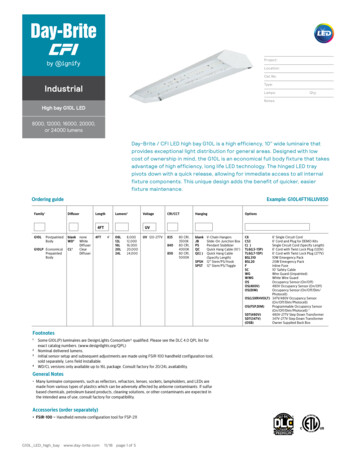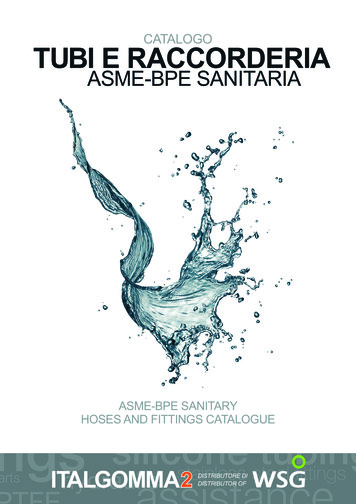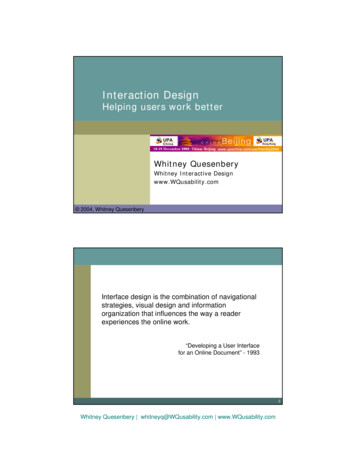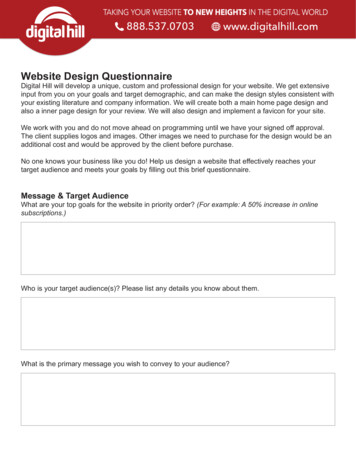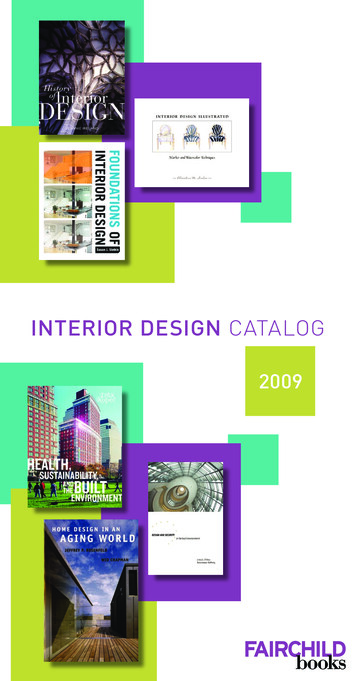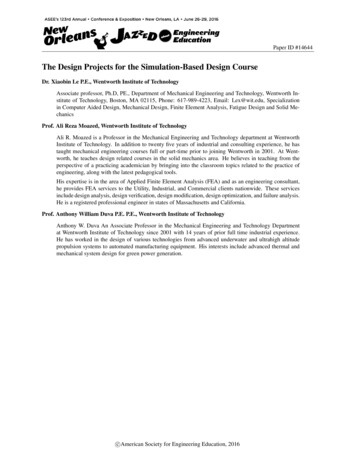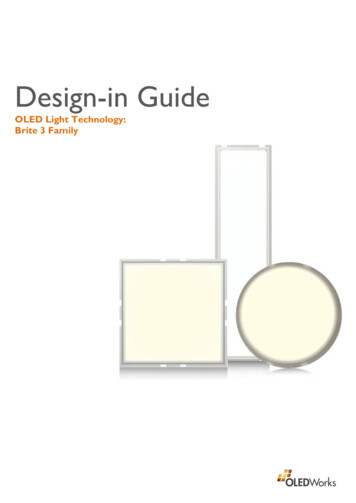
Transcription
Design-in GuideOLED Light Technology:Brite 3 Family
1ContentsIntroduction to this guide . 2Disclaimer . 2This Guide . 3Safety and Warnings . 4Standard compliance and sustainability . 5Structure of an OLED and Brite 3 interfaces . 6Mechanical integration . 8Integration aspects. 8General recommendations for Brite 3 product family. 8Specific recommendations for integration levels 1 and 1.5 . 10Specific recommendations for integration level 2 . 11Cleaning instructions . 11Optical integration . 12Types of optical elements . 12Refractive elements . 12Absorbing elements . 13Electrical integration . 14Driver selection/ requirements: . 14Electrical wiring and contacting . 15Serial interconnection . 15Parallel interconnection . 15Establishing electrical connections (soldering recommendations) . 15Cables. 16Assembly . 17Electrostatic discharge (ESD) . 17Thermal integration . 19Integration aspects. 19General remarks . 19Impact factors . 22Additional information . 31Tc. 31Moisture / humidity . 31
2INTRODUCTION TO THIS GUIDEOLED TECHNOLOGY OFFERS UNIQUE DESIGNS IN LIGHTING APPLICATIONS.When it comes to lighting, OLED inspires on a whole different level. The quality of the light itself incombination with its unique design characteristics, OLED lighting can be used to realize innovativeapplications and designs.The third generation of the Brite family brings OLED further into functional lighting applications. With theluminous flux of up to 300 lumens, the Brite products are the brightest white OLED panel commerciallyavailable worldwide.The rigid OLED panels are available in three shapes, rectangle, round, and square, and two colortemperatures, 3000K and 4000K, making it easy to bring lighting into spaces and products that require highfunction and beautiful illumination.OLED IS A HUMAN-CENTRIC LIGHT SOURCE.Lighting affects our well-being in many ways, from physiological impact to emotional response. OLEDlighting delivers a positive experience for our health in multiple ways.OLED light contains longer wavelengths of blue which are safer for our eyes than the high blue peaks foundin LED lighting. It delivers the same amount of light as LED, in superior quality, with significantly lesshazardous blue light.Validated through the IEC standard for physiological risk of blue and infrared light – our OLEDs have norisk for skin and eyes and are rated as exempt for all photobiological risks.OLED LIGHT IS A NATURALLY DIFFUSE LIGHT SOURCE.OLED provides soft, yet bright full spectrum illumination resulting in artificial light that resembles daylight. Itemits light from the entire surface area, rather than from one or multiple points. This presents a softbrightness and glare-free experience making it an ideal solution for comforting light able to be placed closeto the user. Studies have shown that OLED lighting, in comparison to LED standards, also resulted in lowereye fatigue.DISCLAIMERThe information in this guide is accurate at the time of writing. This guide is provided “as is” withoutexpress or implied warranty of any kind. Neither OLEDWorks nor its agents assume any liability forinaccuracies in this guide or losses incurred by use or misuse of the information in this guide.OLEDWorks will not be liable for any indirect, special, incidental or consequential damages (includingdamages for loss of business, loss of profits or the like), whether based on breach of contract, tort(including negligence), product liability or otherwise, even if OLEDWorks or its representatives have beenadvised of the possibility of such damages.
3This GuideThis design-in guide provides the necessary guidelines for configuring the OLED Brite 3 products into asystem to meet customer needs. The OLED Panel Brite 3 family is designed to enable integration into finalproducts including, but not limited to, appliances, furniture, machine vision and OLED based luminaires infunctional and architectural indoor lighting.The following sections cover1.2.3.4.5.6.Safety and warningsOLED structure and interfacesMechanical integration guidelinesOptical integration guidelinesElectrical integration guidelinesThermal integration guidelinesMany aspects in these six sections are interrelated. We advise reading through all sections before beginninga system design in order to understand how various aspects are interrelated, and to get the best out of theBrite 3 family of products.
4SAFETY AND WARNINGSAll products of the OLEDWorks Brite 3 family meet the requirements of IEC 62868 and UL 8752 and areintended for integration into luminaires, et al. Details are provided in the relevant product datasheets.OLED panels are class III electrical appliances (in accordance with IEC 61140, IEC 60598-1) with accessibleconductive features. These features require adequate insulation, provided, for example, by SELV/UL class 2power supplies and the luminaire or system housing.The final product must meet required certification. For example, a luminaire design must follow standardsappropriate for the intended use of the luminaire, e.g. UL 1598, UL 153, UL 2108 and/or IEC/EN 60598.Luminaire design should account for an increase in OLED voltage over life. Data is provided in the relevanttechnical specifications. The safety standard requirements must also be fulfilled at these increased voltages.OLED panels are made predominantly of glass. They must be integrated into the luminaire so that all partsof the panel are reliably secured to the final product and cannot become loose. The OLED panel must beinstalled so that glass splinters cannot cause harm to the user in the event of breakage. Use gloves alwayswhen handling the OLEDWorks Brite 3 products in order to avoid potentially sharp edges and to limitfingerprints on surface.Defective OLED panels or panels with visible damage must not be used. Damaged OLED panels should bedisconnected from the power supply and must be either disposed of or returned to the manufacturer.OLED panels are not user serviceable.Do NOT bend the OLED twist the OLED / integrate the OLED so that torsion occurs at either room or other temperatures apply point loads to either the front or back of the device write on the device with a pen or similar implement expose the device to high temperatures use defective products use products that have been dropped, even if there is no visible alteration use products that something has been dropped upon, even if there is no visible alteration
5STANDARD COMPLIANCE AND SUSTAINABILITYOLEDWorks products are environmentally friendly and provide efficient illumination without the use ofhazardous materials.This product is RoHS (EU Directive 2011/65/EU) and IEC 62868 (OLED safety) and IEC 62922 (OLEDperformance) compliant.These products are compliant with UL8752 (OLED safety). These products are UL recognized in fileE353273.Within the UL report certain ‘Conditions of Acceptability’ are mentioned as follows. When installed in theend product, the following shall be taken into consideration:1. These products have been evaluated for connection to an isolated DC Class 2 constant currentpower source.Caution: Do not operate the OLED panel with other than UL-Class 2 power supplies.2. This product has been evaluated for use in dry or damp locations.3. The OLED panel temperature shall not exceed 80 C.4. Input leads to the OLEDs are intended for factory installation only. Strain relief to be considered inthe end-use application if leads are subjected to mechanical stress.5. Input leads to the OLED panels shall be sufficiently separated from higher voltage conductors in theend-product in compliance with end-product requirements.
6STRUCTURE OF AN OLED AND BRITE 3 INTERFACESThe following gives a brief description of the Brite 3 panel.OLED, a diode, is a solid-state lighting technology. OLED consists of various layers of organicsemiconductor materials between two electrodes. Applying voltage to both electrodes activatessemiconductor physics that produces light. Light is generated evenly across the entire panel surface, incontrast to point sources of tradition (inorganic) LEDs.Considerations for optimum performance when integrated in end products include: Electrical energy not converted to light will result in heat generation. Since temperature affects theOLED operation (see section ?), management of heat is integral to the OLED panel design andshould be maintained during integration.Exposing the organic materials to air and water will result in failure. Maintaining the protectionsincorporated in the panel configuration is vital.Brite 3 Level 1 configuration is shown in Figure 1 and described below:1. Functional organic layer: semiconductor carbon-based materials formulated for white light emission2. Glass substrate: Primary structural element, transparent to visible wavelengths, protects OLEDfrom exposure to environment3. Optical foil: Scattering layer facilitates light extraction from glass and protects OLED from UV4. Anode: Transparent Electrode5. Cathode: Metallic Electrode also acts as reflector6. Encapsulation: Thin-film encapsulation provides robust protection from environment7. Metal Foil: Heat spreader to ensure uniform temperature across panel8. PCB: A frame around panel perimeter, provides electrical interface to anode and cathode9. Light Emission: Uniform in color, across entire surface, and all viewing anglesFigure 1: Schematic of Brite 3 Panel, Level 1
7Brite 3 Level 2 provides additional thermal and structural support, if needed. The addition of a thermal padand metal black plate improves heat dissipation through radiation. Notches in the back plate are providedto enable the plate to be mounted with screws.Brite 3 Level 2 configuration is shown in Figure 2 and described below, staring with level 1 configuration:10. Heat pad: thermally conductive adhesive element11. Metal back plate: provides added rigidity and radiative component to heat dissipation12. Cable: wire attachment to PCB to connect with panel anode and cathodeFigure 2: Schematic of Brite 3 Panel, Level 2Note that integration Level 1.5, not shown, is level 1 with the addition of the cable harness only.Managing temperature across the panel is important for overall OLED operation, consistency and lifetime.Integration level 1 (and 1.5) and level 2 have slightly different electrical and optical performance due todifferences in heat dissipation; notably, level 2 with the metal back-plate potentially has reducedtemper
eye fatigue. DISCLAIMER. The information in this guide is accurate at the time of writing. This guide is provided “as is” without express or implied warranty of any kind. Neither OLEDWorks nor its agents assume any liability for inaccuracies in this guide or losses incurred by use or misuse of the information in this guide. OLEDWorks will not be liable for any indirect, special, incidental .
